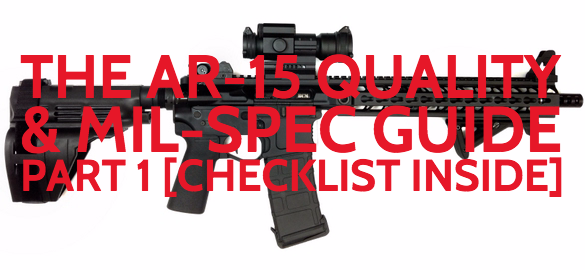If you’ve ever wondered what makes an AR-15 rifle quality, one that you can bet your life on, then this article will explain it to you.
Because the popularity of the AR-15 pattern rifle has exploded in the last 10+ years (since the expiration of the Federal Assault Weapon ban in 2004) — there are now hundreds, if not thousands, of manufacturers of America’s favorite rifle.
Some are quite literally junk that you should not waste your money on.
Others are top of the line. And still others are solid buys for the money.
But what SHOULD you be looking for?
What defines a quality rifle and what makes it functionable, reliable and an AR-15 that you know you can trust your life with?
In other words, what are the standards that define a well-made AR-15?
Also, we’ll talk about what the term “Mil-Spec” really means and how important it is in getting a quality rifle.
What you should look for in an AR-15
When I first got into AR-15’s and started wanting one myself, I had no idea what was what. Every rifle looks the same after all!
The fact is the AR-15 design has been around for decades, and lots of people know how to build them, so the question becomes what quality control is there?
There really isn’t.
That’s why some sort of “minimum standard” will give you a baseline for “what to look for” in an AR-15 to know if it’s quality. This is what Mil-Spec is supposed to be.
What is Mil-Spec & how important is it really?
Mil-Spec simply refers to the military specifications that every M16 or M4-pattern carbine must meet in order to be accepted for use by the U.S. military. There are only two companies that I know of that actually produce these rifles for the U.S. military — Colt & FN Herstal.
So, in short, Mil-Spec contains minimum standards that the military has found make the AR-15 style rifle the most reliable and functional.
Now, keep in mind, that I say “minimum” standards because the mil-spec standards that we are talking about were drafted in the 1960’s and 70’s. To think there haven’t been improvements in the AR-15 platform since that time — or acceptable deviations from mil-spec — would be shortsighted.
The MOST important quality checklist:
With that being said, arguably the most important checklist that an AR-15 rifle should pass the minimum Mil-Spec standards for is with the “Bolt Carrier Group” also known as the BCG.
This is the critical part that flies back and forth in the upper receiver extracting and ejecting empty casings, chambering live rounds, and generally ensuring your AR-15 operates as it should.
Because of this, when we’re talking about reliability, the BCG is arguably the HEART of the gun. And having one that’s made to the proper specs and assembled to the proper specs (and properly checked for flaws/tested by the manufacturer) is critical to owning a reliable AR-15.
This is the checklist that you want to see a “YES” for when examining the BCG of your AR-15:
*** “Full-Auto” M16 profile Bolt Carrier
*** Shot Peened Bolt
*** High Pressure Test (HPT) Bolt
*** Magnetic Particle Inspection (MPI) Bolt
*** Properly Staked Gas Key
And those are the most important things that make a Bolt Carrier Group reliable.
How do you know if your AR-15 meets these minimum standards?
The truth is, that anyone that knows anything about the AR-15 platform knows that these are SELLING points — so if the AR-15 you’re looking at meets these standards, the manufacturer will want you to know!
We are just getting started, and we’ve only covered the Bolt Carrier Group at this time. In my next article we’ll talk about the next most important part of the AR-15 when it comes to quality, reliability and performance you can trust your life to.
